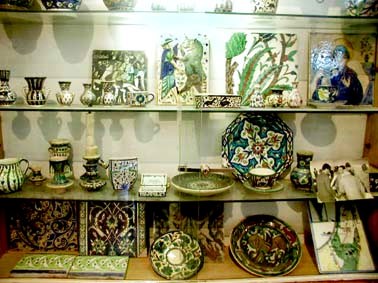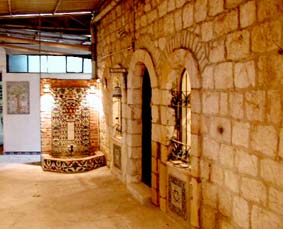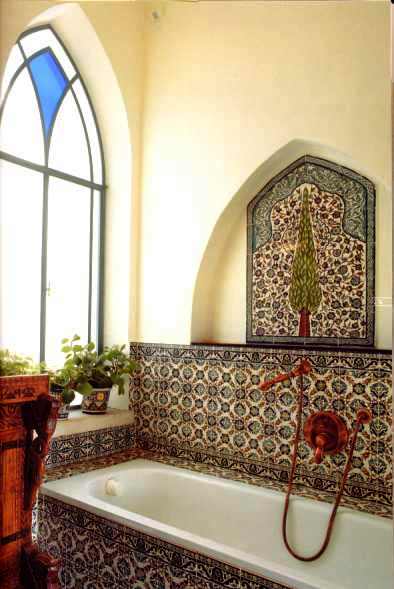
 The Armenian Ceramics of Old
The Armenian Ceramics of Old
By Sylvia Bourdjian-Matta
Azad-Hye,
The business is currently operated by Neshan Balian Jr., whose grandfather Neshan Balian, a master potter, came to
We contacted Mr. Neshan Balian Jr. and asked him the following questions:
– What is remarkable in the Balian pottery and why do you call yourself ?Ceramics of Palestine??
There are quite a few so called Armenian ceramics artists in
I think the most remarkable aspect about Balian pottery is that we produce all of our pottery ourselves. We do this from scratch; meaning we import the plastic clay from
The reason the place is called Palestinian Pottery is that when the studio was established by my grandfather Neshan Balian and Mr. Karakashian senior in 1922, it was called Palestine Pottery. When the Balians and Karakashians separated, my father changed the name from ?
– How can somebody recognize the Balian pottery? Do you have any sign on your products?
We have distinctive inscriptions behind all of our pottery. The name ?
– Is there any Balian ceramic piece of art used in a world-known monument, apart from the Dome of the Rock in
I can mention a beautiful meditation center in
– What is remarkable in Armenian pottery (color, form, design?etc)?
I think the question should be what is remarkable about ?The Armenian Pottery of Jerusalem? rather than Armenian pottery. Armenian pottery is an identity of  influence of my mother Marie Balian. She gave new life to the designs which my grandfather and Mr. Karakashian Sr. were reproducing from the Kutahya influence. With her French Beaux art training and talent she introduced gazelles, birds and the animals which were never an important part of the Kutahya repertoire. Her loose and free floral curves and patterns is what started attracting Israeli artists and journalists to the factory, and slowly some of them started realizing that this really is a unique form of art very different form anything else and with its own identity. Once articles started being written, books about us being printed and museums exhibitions opening then the ?Armenian Ceramics of Jerusalem? term was coined. Once the fame started, then a lot of young people around the Armenian convent started to take advantage of this fame by setting up small studios and using the Armenian Ceramics name. Some were talented and evolved their different styles but most just copied our work.?
influence of my mother Marie Balian. She gave new life to the designs which my grandfather and Mr. Karakashian Sr. were reproducing from the Kutahya influence. With her French Beaux art training and talent she introduced gazelles, birds and the animals which were never an important part of the Kutahya repertoire. Her loose and free floral curves and patterns is what started attracting Israeli artists and journalists to the factory, and slowly some of them started realizing that this really is a unique form of art very different form anything else and with its own identity. Once articles started being written, books about us being printed and museums exhibitions opening then the ?Armenian Ceramics of Jerusalem? term was coined. Once the fame started, then a lot of young people around the Armenian convent started to take advantage of this fame by setting up small studios and using the Armenian Ceramics name. Some were talented and evolved their different styles but most just copied our work.?
– What are your future plans and goals?
There are two choices you can make; either stay small as a two person studio as most others or expand to become a much larger operation. I have chosen the latter and have studios in
Before the arrival of Neshan Balian to
1965 saw the amicable end of partnership between the Balian and the Karakashian families with the Balian family remaining on the present premises and continuing the tradition of this unique form of pottery.
 The factory was destroyed totally in the 1967 Arab-Israeli war except for the huge dome furnace with a full load of fired ceramics which was sold and helped in the reconstruction. Lack of raw materials in the early 30s and 40s was also a problem with homemade solutions of breaking bottle glass and crushing it as ways to prepare badly needed glazes, but eventually Neshan Balian and his son Setrak overcame these problems and the factory started to prosper.
The factory was destroyed totally in the 1967 Arab-Israeli war except for the huge dome furnace with a full load of fired ceramics which was sold and helped in the reconstruction. Lack of raw materials in the early 30s and 40s was also a problem with homemade solutions of breaking bottle glass and crushing it as ways to prepare badly needed glazes, but eventually Neshan Balian and his son Setrak overcame these problems and the factory started to prosper.
Setrak Balian took over the Armenian ceramics factory in 1965 after the death of his father. He studied ceramics in
Setrak?s wife Marie Balian, who is of French Armenian heritage, is a world renowned ceramic tile artist. Her ceramic tile murals have been exhibited all over the world including a solo one in 1992 at The Smithsonian Museum in
Since 1996, Neshan Balian Jr. has been managing the factory after the passing away of his father, Setrak. He holds both a mechanical and ceramic engineering degrees from
Original and authentic Balian Armenian Ceramics are only sold in their factory and retail outlet on
The tiles and pottery of Balian Armenian ceramics have been exhibited all over the world in various museums and institutions. Their pottery has also been the subject of numerous articles in magazines and newspapers worldwide.
Photos:
1- Balian family ceramics collection.
2- Entrance to the ceramics museum.
3- Sample of a ceramic-made bathroom

An excellent touch and summary of one of our “lost” treasures.
Thank you
Zarmine
My origins are too from Kutahya in Armenian Gudina. From 1974 to 1979 I have studied in the Armenian Quarter Dadurian Tarkmanchats School and after that in Jarankavorats Varjaran. I had contacts with Balian Family there. There is a very good book about our history in Armenian (Batmutyun Gudinayi Hayots).
Sarkis Aram Bakerdjian
[email protected]
Brussels, Belgium
Fascinating article–a couple of corrections. Neshan Balian came to Jerusalem in October 1919, not 1917. The British were not even in Jerusalem until mid-December 1917. The Armenian ceramist David Ohannessian of Kutahya was introduced to Jerusalem Governor Ronald Storrs by Sir Mark Sykes in December 1918, and was the first to arrive. Sykes, Storrs, and a number of other British officials remembered the magnificent tiled room that Ohannessian had created for the Sykes estate in Yorkshire in 1913, and sought him out to establish a ceramics tradition in Jerusalem. Ohannessian arrived in Jerusalem in early 1919, and then went back to Kutahya in August 1919, returning with materials and with Balian and Karakashian, who were under his employ until 1922, when they left to found their own joint workshop. It is wonderful to see that the descendants of Balian and Karakashian continue their marvelous work today.